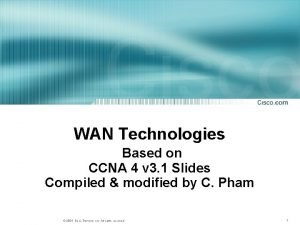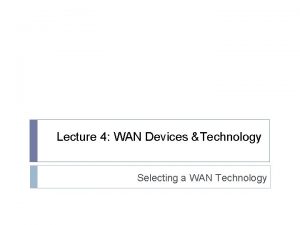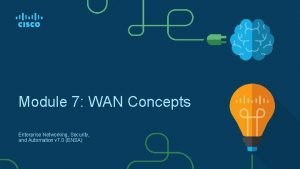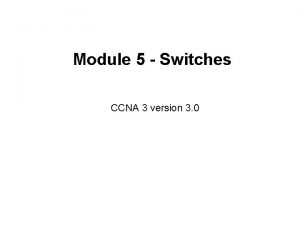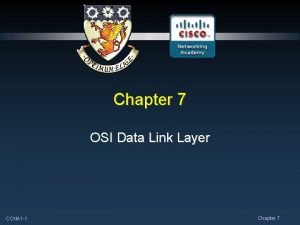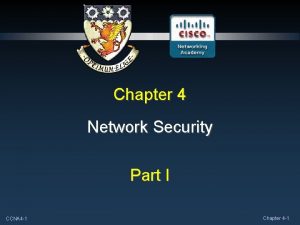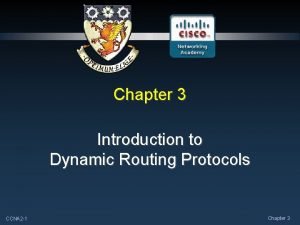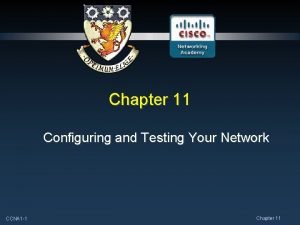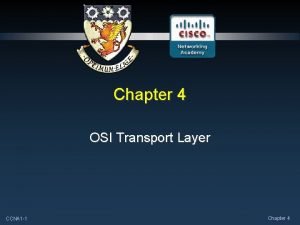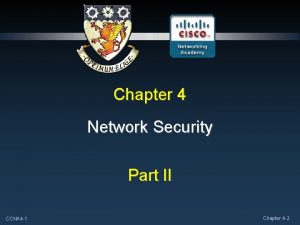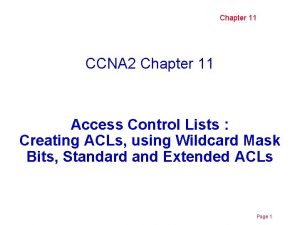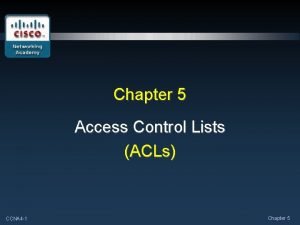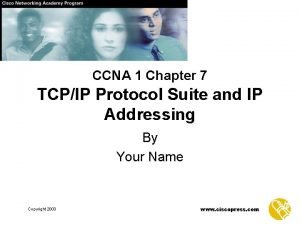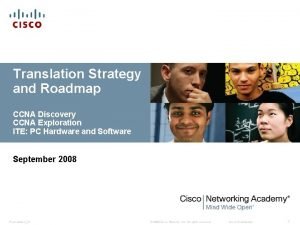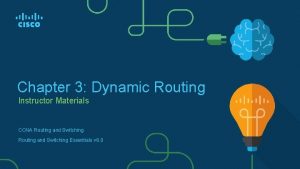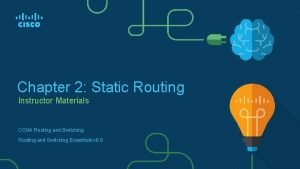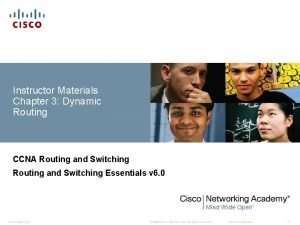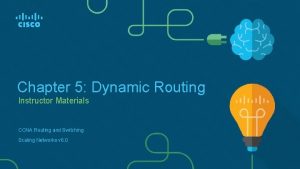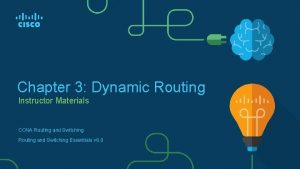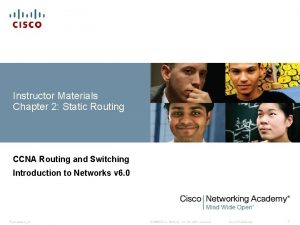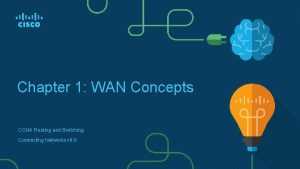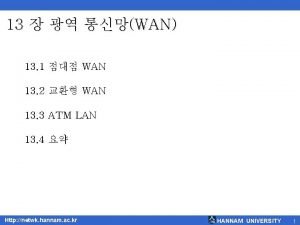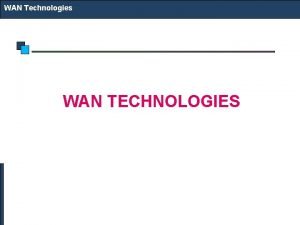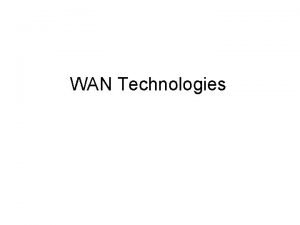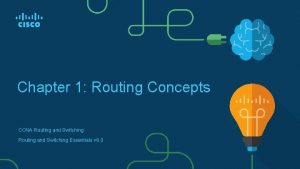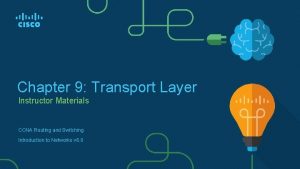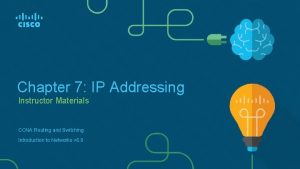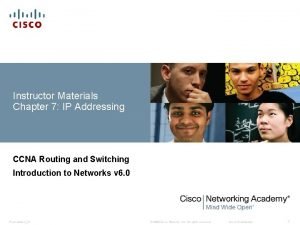Instructor Materials Chapter 1 WAN Concepts CCNA Routing






























- Slides: 30

Instructor Materials Chapter 1: WAN Concepts CCNA Routing and Switching Connecting Networks Presentation_ID © 2008 Cisco Systems, Inc. All rights reserved. Cisco Confidential 1

Chapter 1: WAN Concepts Connecting Networks Presentation_ID © 2008 Cisco Systems, Inc. All rights reserved. Cisco Confidential 9

Chapter 1 - Sections & Objectives § 1. 1 WAN Technologies Overview • Explain WAN access technologies available to small to medium-sized business networks. § 1. 2 Selecting a WAN Technology • Select WAN access technologies to satisfy business requirements. Presentation_ID © 2008 Cisco Systems, Inc. All rights reserved. Cisco Confidential 10

1. 1 WAN Technologies Overview Presentation_ID © 2008 Cisco Systems, Inc. All rights reserved. Cisco Confidential 11

WAN Technologies Overview Purpose of WANs § WANs connect LANs § WANs are used to connect remote sites to the enterprise network. § WANs connect home users to the Internet. § Enterprise networks are using security and privacy solutions over the Internet to connect remote sites and users. Presentation_ID © 2008 Cisco Systems, Inc. All rights reserved. Cisco Confidential 12

WAN Technologies Overview Point-to-Point Purpose of WANs § Common WAN topologies are: • Point-to-Point – Typically a dedicated leasedline connection such as T 1/E 1 • Hub-and-Spoke – A single-homed, point-tomultipoint topology where a single interface on the hub router can be shared with multiple spoke routers through the use of virtual interfaces Hub-and-Spoke Full Mesh • Full Mesh – Each router has a connection to every other router; requires a large number of virtual interfaces • Dual-homed – Provides redundancy for a single-homed, hub-and-spoke topology by providing a second hub to connect to spoke routers Presentation_ID © 2008 Cisco Systems, Inc. All rights reserved. Dual-Homed Cisco Confidential 13

WAN Technologies Overview Purpose of WANs Small Office § As businesses grow, the topologies and WAN strategies change: • Small Office – These businesses typically consist of one LAN at one location that connects to the Internet through a broadband technology. • Campus Network – A small- to medium-sized business with one location and multiple LANs uses specialized equipment and technologies to connect to the Internet. • Branch Networks – As the business grows, it adds more branch offices, each with its own campus network. WAN contracts to connect the remote networks are negotiated. • Distributed Network – A multinational business has a network distributed across the globe. These businesses have complex WAN strategies to securely connect to regional offices, branch offices, partners, and telecommuters. Presentation_ID Campus Network Distributed Network © 2008 Cisco Systems, Inc. All rights reserved. Cisco Confidential 14

WAN Technologies Overview WAN Operations § WAN operations focus primarily on the physical layer (OSI Layer 1) and the data link layer (OSI Layer 2). • Layer 1 protocols describe how to provide electrical, mechanical, operational, and functional connections • Layer 2 protocols define how data is encapsulated § WAN Terms include: • Customer Premises Equipment (CPE) – owned by the business or leased from the service provider. • Data Communications Equipment (DCE) – provides an interface to connect subscribers to a communication link on the WAN cloud. • Data Terminal Equipment (DTE) – connects to the local loop through the DCE. • Demarcation Point – separates customer equipment from service provider equipment and is the place where the responsibility for the connection changes from the user to the service provider. • Local Loop – cable that connects the CPE to the CO of the service provider (last mile). • Central Office (CO) – local service provider facility or building that connects the CPE to the provider network. • Toll network – all the cabling and equipment inside the WAN provider network. Presentation_ID © 2008 Cisco Systems, Inc. All rights reserved. Cisco Confidential 15

WAN Technologies Overview WAN Operations § WAN devices include: • Dialup modem – legacy WAN technology that converts digital signals into voice frequencies to be transmitted over the analog lines of the public telephone network. • Access server – legacy WAN technology that coordinates dial-in and dial-out user communications. • Broadband modem – used with high-speed DSL or cable Internet service • CSU/DSU – used to convert digital, leased-line signals into frames that the LAN can interpret and vice versa. • WAN switch – multiport internetworking device used in service provider networks • Router – provides internetworking and WAN access interface ports to connect to the service provider network • Core router/Multilayer switch – resides within the backbone of the WAN, supports multiple interfaces, and forwards IP packets at full line speed Presentation_ID © 2008 Cisco Systems, Inc. All rights reserved. Cisco Confidential 16

WAN Technologies Overview WAN Operations Circuit-Switched § WANs can operate as circuitswitched or packet-switched networks: • Circuit-switched Networks – establish a dedicated circuit between source and destination before the users may communicate, such as making a telephone call • Packet-Switched Networks – split traffic into packets that are routed over a shared network and do not require a dedicated circuit between source and destination Presentation_ID Packet-Switched © 2008 Cisco Systems, Inc. All rights reserved. Cisco Confidential 17

1. 2 Selecting a WAN Technology Presentation_ID © 2008 Cisco Systems, Inc. All rights reserved. Cisco Confidential 18

Selecting a WAN Technology WAN Services Two way that a business can get WAN access: § Private WAN Infrastructure • The business negotiates for dedicated or switched WAN access with a service provider. § Public WAN Infrastructure • Presentation_ID WAN access is achieved through the Internet using broadband connections. VPNs secure the connections. © 2008 Cisco Systems, Inc. All rights reserved. Cisco Confidential 19

Selecting a WAN Technology WAN Services (cont. ) This topology illustrates some of these WAN access technologies. Presentation_ID © 2008 Cisco Systems, Inc. All rights reserved. Cisco Confidential 20

Selecting a WAN Technology Private WAN Infrastructures Dialup Advantages: Disadvantages: § Simplicity § Cost § Quality § Limited flexibility § Availability Presentation_ID © 2008 Cisco Systems, Inc. All rights reserved. Cisco Confidential 21

Selecting a WAN Technology Private WAN Infrastructures (Cont. ) Sample ISDN Topology ISDN BRI Presentation_ID ISDN PRI © 2008 Cisco Systems, Inc. All rights reserved. Cisco Confidential 22

Selecting a WAN Technology Private WAN Infrastructures (Cont. ) Frame Relay § PVCs carry both voice and data traffic. § PVCs are uniquely identified by a data-link connection identifier (DLCI). § PVCs and DLCIs ensure bidirectional communication from one DTE device to another. § R 1 uses DLCI 102 to reach R 2 while R 2 uses DLCI 201 to reach R 1. Presentation_ID © 2008 Cisco Systems, Inc. All rights reserved. Cisco Confidential 23

Selecting a WAN Technology Private WAN Infrastructures (Cont. ) ATM Built on a cell-based architecture, rather than on a frame-based architecture. ATM cells are always a fixed length of 53 bytes. Presentation_ID © 2008 Cisco Systems, Inc. All rights reserved. Cisco Confidential 24

Selecting a WAN Technology Private WAN Infrastructures (Cont. ) Ethernet WAN Features and Benefits of Ethernet WAN include: § Reduced expenses and administration § Easy integration with existing networks § Enhanced business productivity § Service providers now offer Ethernet WAN service using fiber-optic cabling. § Known as Metropolitan Ethernet (Metro. E), Ethernet over MPLS (Eo. MPLS), and Virtual Private LAN Service (VPLS). Presentation_ID Note: Commonly used to replace the traditional Frame Relay and ATM WAN links. © 2008 Cisco Systems, Inc. All rights reserved. Cisco Confidential 25

Selecting a WAN Technology Private WAN Infrastructures (Cont. ) MPLS Multiprotocol Label Switching (MPLS) is a multiprotocol high-performance WAN technology that directs data from one router to the next, based on short path labels rather than IP network addresses. Presentation_ID © 2008 Cisco Systems, Inc. All rights reserved. Cisco Confidential 26

Selecting a WAN Technology Private WAN Infrastructures (Cont. ) VSAT Very small aperture terminal (VSAT) - a solution that creates a private WAN using satellite communications. Presentation_ID © 2008 Cisco Systems, Inc. All rights reserved. Cisco Confidential 27

Selecting a WAN Technology Public WAN Infrastructures DSL § Always-on connection technology that uses existing twisted-pair telephone lines to transport highbandwidth data, and provides IP services to subscribers. § A DSL modem converts an Ethernet signal from the user device to a DSL signal, which is transmitted to the central office. Presentation_ID © 2008 Cisco Systems, Inc. All rights reserved. Cisco Confidential 28

Selecting a WAN Technology Public WAN Infrastructures (Cont. ) Cable § Network access is available from some cable television networks. § Cable modems provide an alwayson connection and a simple installation. Presentation_ID © 2008 Cisco Systems, Inc. All rights reserved. Cisco Confidential 29

Selecting a WAN Technology Public WAN Infrastructures (Cont. ) Wireless New developments in broadband wireless technology: § Municipal Wi-Fi – Many cities have begun setting up municipal wireless § Wi. MAX – Worldwide Interoperability for Microwave Access (Wi. MAX) is a new technology that is just beginning to come into use. § Satellite Internet - Typically used by rural users where cable and DSL are not available. Presentation_ID © 2008 Cisco Systems, Inc. All rights reserved. Cisco Confidential 30

Selecting a WAN Technology Public WAN Infrastructures (Cont. ) 3 G/4 G Common cellular industry terms include: § 3 G/4 G Wireless – Abbreviation for 3 rd generation and 4 th generation cellular access. These technologies support wireless Internet access. § Long-Term Evolution (LTE) – A newer and faster technology, considered to be part of the 4 th generation (4 G) technology. Presentation_ID © 2008 Cisco Systems, Inc. All rights reserved. Cisco Confidential 31

Selecting a WAN Technology Public WAN Infrastructures (Cont. ) § Public WANs rely on VPNs for securing data between private networks as it crosses a public network, such as the Internet. Site-to-Site § Benefits: • Cost savings • Security • Scalability Remote-Access • Compatibility with broadband technology § Two types of VPN: • Site-to-site VPNs • Remote-access VPNs Presentation_ID © 2008 Cisco Systems, Inc. All rights reserved. Cisco Confidential 32

Selecting a WAN Technology Selecting WAN Services Answer the following questions when choosing a WAN Connection: Presentation_ID © 2008 Cisco Systems, Inc. All rights reserved. Cisco Confidential 33

1. 3 Summary Presentation_ID © 2008 Cisco Systems, Inc. All rights reserved. Cisco Confidential 34

Chapter Summary § WAN access standards operate at Layers 1 and 2 of the OSI model. § Permanent, dedicated point-to-point connections are provided by using leased lines. § Private WAN connections include: § Public WAN connections include: Dialup DSL ISDN Cable Frame Relay Wireless ATM Cellular Metro Ethernet MPLS VSAT § Security over public infrastructure connections can be provided by using remote-access or site-to-site Virtual Private Networks (VPNs). Presentation_ID © 2008 Cisco Systems, Inc. All rights reserved. Cisco Confidential 35

Presentation_ID © 2008 Cisco Systems, Inc. All rights reserved. Cisco Confidential 36

Presentation_ID © 2008 Cisco Systems, Inc. All rights reserved. Cisco Confidential 37
 Wan technologies ccna
Wan technologies ccna Difference between reservoir routing and channel routing
Difference between reservoir routing and channel routing Static routing and dynamic routing
Static routing and dynamic routing Continuity equation hydrology
Continuity equation hydrology Difference between clock routing and power routing
Difference between clock routing and power routing Private wan vs public wan
Private wan vs public wan Lab 4-1: routing concepts and protocols
Lab 4-1: routing concepts and protocols Wan concepts
Wan concepts Wan concepts
Wan concepts Wan concepts
Wan concepts Ccna 3 chapter 1
Ccna 3 chapter 1 What is a function of the data link layer ccna
What is a function of the data link layer ccna Ccna 4 chapter 4
Ccna 4 chapter 4 Modern network security
Modern network security Ccna 4 chapter 1
Ccna 4 chapter 1 Ccna 4 chapter 7
Ccna 4 chapter 7 Ccna 2 chapter 3
Ccna 2 chapter 3 Ccna chapter 11
Ccna chapter 11 Ccna 1 chapter 4
Ccna 1 chapter 4 Ccna 4 chapter 4
Ccna 4 chapter 4 Ccna chapter 11
Ccna chapter 11 Ccna 4 chapter 5
Ccna 4 chapter 5 Ccna 1 chapter 7
Ccna 1 chapter 7 Natural materials and man made materials
Natural materials and man made materials What is useful and harmful materials
What is useful and harmful materials Natural materials and man made materials
Natural materials and man made materials What is adopting materials
What is adopting materials Direct materials budget with multiple materials
Direct materials budget with multiple materials Ccna drugs
Ccna drugs Ccna
Ccna Sybex ccna
Sybex ccna
